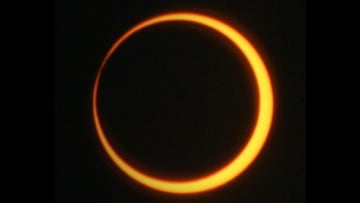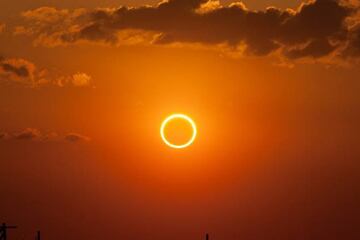What countries will be able to see the hybrid solar eclipse and where can’t it be seen from?
On the night of Thursday, April 20, a rare total solar eclipse will take place. This phenomenon will only occur seven times in the entire 21st century.

This year, spring will host a very unique evening: Thursday, 20 April, will be historic.
Like many words in English, the term ‘eclipse’ comes from Greek. The word ‘ekleipsis’ used to be used to talk about the ‘disappearance’ of the sun or the moon. Although this word encompasses all aspects of this phenomenon, the reality is that not all eclipses are the same. The one that is about to occur is the annular-total type and will only occur seven times in the entire century.
Watch the total solar eclipse live.
Why is this eclipse important?
This is a particular eclipse in which the sky progressively darkens for four hours. First, there will be partial sun blocking and, finally, it will be complete hidden. In the intermediate stages, what is known as the ‘ring of fire’ will be visible: a luminous ring resulting from the last igneous flashes from the edge of the sun.

The last time a similar eclipse occurred was 18 years ago, according to NASA. Its uniqueness is such that the space agency has already named this hybrid solar eclipse as Ningaloo, a part of western Australia from which the eclipse will be most visible. The sky will not enjoy this same phenomenon again this century until 2031, then in 2049, 2050, and finally 2067.
Where can the hybrid solar eclipse be seen and at what time?
The luxury of being able to see the phenomenon belongs to few countries. According to the National Geographic Institute, the eclipse will begin at 2:34 a.m. peninsular time in the Indian Ocean and end at 7:59 a.m. in the Pacific. The full duration is 325 minutes, although the culmination of the phenomenon will take place at 3:34 a.m. and will last 74 seconds.
However, all those who wish to see the phenomenon may do so through NASA’s YouTube channel, which will broadcast it live. You can also watch it here on AS USA.
Due to the rotation and inclination of the planet, the skies of Australia, Indonesia, New Zealand and Papua New Guinea will give a special night to all its inhabitants.
Another unique night that spring has up its sleeve will be May 5th. At the beginning of next month, another eclipse will take place; in this case, of the penumbral lunar type.






